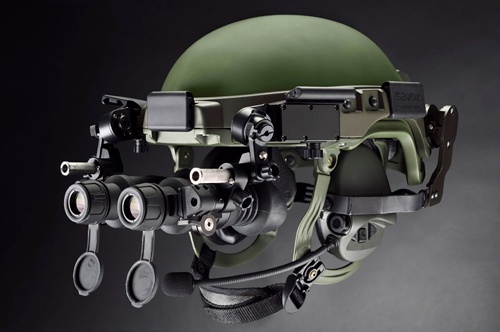Are NVGs Giving You a Pain in the Neck?…….. Not Any More.

Authored by Jaakko Havola, Product Manager, Savox Communications
Today’s modern western defense forces utilize a variety of night vision goggles (NVGs) depending on type of troop and specific mission requirements. Most typically the NVG is treated as an add-on solution: The chosen goggles are bolted, screwed and strapped upon an existing helmet. However, newer integrated helmet designs now provide significant benefits in terms of comfort, safety and cost-savings.
What’s so great about newer integrated helmet designs? Here’s the rundown.
Weight & Balance
Old Way: Wearing a traditional non-integrated helmet with NVGs can literally give you a pain in the neck. Not only is the weight of the helmet itself problematic, but adding a night vision goggle as an afterthought compounds the issue because now a counter weight (read “dead weight”) must also be added to keep the entire system positioned correctly on the head.
New Way: Newer, integrated tactical headgear system designs offer distinct advantages concerning weight and balance. In general, newer helmet designs are significantly lighter than traditional helmets. As well, the balance point of integrated helmet designs is optimized from the start to account for goggle use, and at the same time, a centralized power source for the entire system is integrated within the design to provide an optimally balanced helmet and greater comfort for the wearer.
Compromised Safety
Old Way: Using non-integrated NVGs mounted on helmets pose distinct safety hazards for wearers. Typically the goggles are bolted onto the helmet by drilling holes in the helmet itself. By doing this, the original design and usability of the helmet is totally compromised. Who is to warrant the functionality and safety of this new combination of NVG's, helmet and mounting hardware?
New Way: With integrated night vision goggles there are no compromised safety issues. A totally boltless NVG mounting solution provides the highest possible protection against battlefield threats. From the get-go, the ballistic helmet and goggles are designed to work together as a single (and safe) unit.
Cost of Ownership
Old Way: Typically, non-integrated goggles are mounted on top and front of the ACH helmet or Fast helmet types. This front and top carrying position of the bolt-on goggles pose significant hazards to the goggles themselves. For instance, if during disembarkation from an armored personnel carrier (APC), the wearer doesn’t remember to flip the goggles down prior to landing, serious damage can occur to this expensive and delicate piece of equipment. Even at low impact, these types of smash-ups can occur when goggles are in storage position at the top of the helmet. Impacts – either high or low - have the same result: The goggles need to be either repaired or replaced. Ouch.
And, in addition to the cost aspect of damaged equipment, there’s also the issue of aborted or changed mission plans due to mal-functioning and/or damaged equipment.
New Way: This is a clear improvement point where the next generation of integrated tactical headgear systems can and will provide a great improvement to both the usability as well as cost of ownership. Having a system design that allows the night vision goggles to have a carrying position below the impact point of the helmet is imminently advantageous from a monetary ROI perspective. As well, field operations can feel more secure that their team members can carry out their duties with functioning, rather than damaged, equipment.
Above is just a brief synopsis of the benefits of integrated helmet designs. If you should have any questions or comments concerning integrated helmets and their design, please feel free to contact me directly. And check out Savox Communications latest integrated helmet design, THOR.
Want to learn more?
Jaakko Havola
Subcribe to our blog
Be among the first of your peers to hear about the new products and solutions from Savox.

